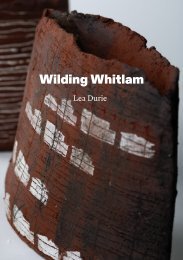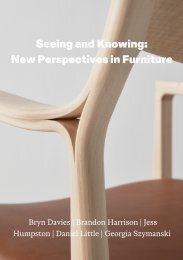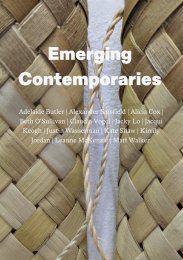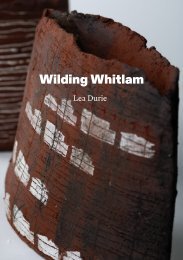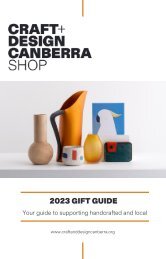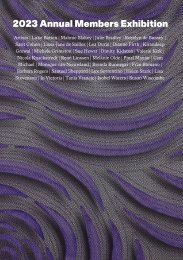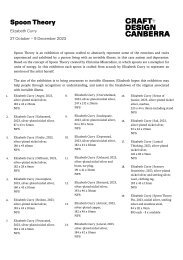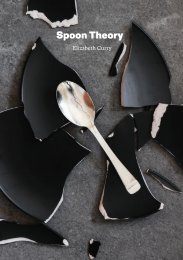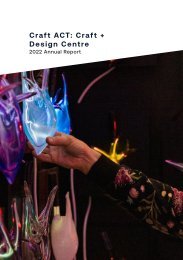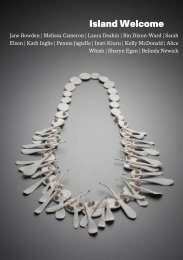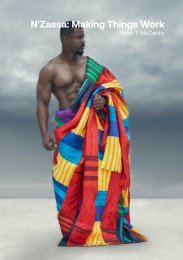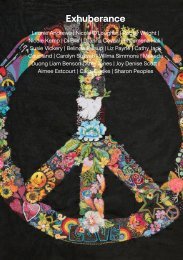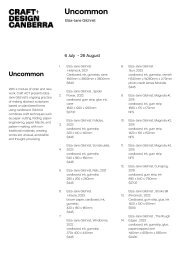Craft ACT Artist-in-residence 2018: Cupped Hands
Vicky Shukuroglou and Simon Cottrell
Vicky Shukuroglou and Simon Cottrell
You also want an ePaper? Increase the reach of your titles
YUMPU automatically turns print PDFs into web optimized ePapers that Google loves.
MIND<br />
Vicky Shukuroglou & Simon Cottrell<br />
S<strong>in</strong>ce early childhood we have both been closely<br />
observ<strong>in</strong>g the ‘natural world’, with a strong sense of<br />
be<strong>in</strong>g a part of ‘nature’, not separate to it. For the<br />
last 25 years we have walked thousands of kilometres<br />
together, learn<strong>in</strong>g through <strong>in</strong>timate experience of<br />
this remarkable and ancient land. To delve deeper<br />
we’ve needed to be open-m<strong>in</strong>ded and question all<br />
that we do not understand. We must also question<br />
what we th<strong>in</strong>k we understand. Curiosity and care are<br />
vital here. They are the antidote to assumption or<br />
superficial op<strong>in</strong>ion. This is the ethos which guides<br />
our work.<br />
biodiversity; people who record the provenance of<br />
every <strong>in</strong>dividual plant on the 40 hectare site. Bear<br />
<strong>in</strong> m<strong>in</strong>d you won’t see a larger liv<strong>in</strong>g collection<br />
of Australian plants. At the ANBG you will also<br />
f<strong>in</strong>d a remarkable range of volunteers, who, <strong>in</strong><br />
understand<strong>in</strong>g the significance of the work, f<strong>in</strong>d<br />
the will to contribute their care, time and energy.<br />
They weed the gardens, walk with visitors to unveil<br />
the f<strong>in</strong>e layers of botanical complexity, and lov<strong>in</strong>gly<br />
gather and clean thousands of seeds for the security<br />
and rehabilitation of our country. Australia, you have<br />
a treasure here.<br />
In many ways a project like <strong>Cupped</strong> <strong>Hands</strong> has<br />
been wait<strong>in</strong>g at our core, and we are grateful for<br />
the opportunities this residency enables. Through<br />
our collaboration we seek to awaken the senses to<br />
the <strong>in</strong>f<strong>in</strong>ite complexity of ecosystems with<strong>in</strong> which<br />
humans have evolved. By <strong>in</strong>vit<strong>in</strong>g hearts and m<strong>in</strong>ds<br />
to become deeply immersed <strong>in</strong> these relationships,<br />
we aim to reignite curiosity and reverence for our<br />
earth. We hope to heighten compassion through<br />
strengthen<strong>in</strong>g connections to country.<br />
We have long known that the Australian National<br />
Botanic Gardens (ANBG) is a place of rigorous<br />
research, not just an enchant<strong>in</strong>g and biodiverse<br />
garden. Dur<strong>in</strong>g our residency, the more we looked<br />
the more we learnt, the more we acknowledged<br />
how much there is to know. The more we learnt<br />
the more deeply we understood its complexity.<br />
We experienced the ANBG’s generous spirit, and<br />
we cont<strong>in</strong>ue to be enthralled by the aspirations of<br />
the many people <strong>in</strong>volved. Walk <strong>in</strong>to the offices,<br />
the cryptogam, herbarium, nursery, or seed bank,<br />
and you will discover people work<strong>in</strong>g with fervent<br />
commitment and collaboration, through careful<br />
observation and gentle response. You may meet<br />
people who have been work<strong>in</strong>g on one rare species<br />
for 25 years, rebuild<strong>in</strong>g its genetic strength that has<br />
dim<strong>in</strong>ished under recent human presence; people<br />
who collaborate with similar <strong>in</strong>stitutions across the<br />
world aim<strong>in</strong>g to understand and preserve the earth’s<br />
Let’s consider that Australia has more known<br />
endemic species than any other country.<br />
That means approximately 87% of Australia’s<br />
mammals, 45% of birds, 86% of vascular plants,<br />
93% of reptiles and 94% of amphibians are found<br />
NOWHERE ELSE ON EARTH. 1 Can we ignore these<br />
facts <strong>in</strong> our every day? Whose responsibility is it to<br />
ensure the vitality of the earth that susta<strong>in</strong>s all life?<br />
There are valleys, fens, peaks, rivers and grasslands<br />
of Namadgi National Park replete with ancient signs<br />
of care and attention. We can see the evidence <strong>in</strong><br />
the soils that are alive and held together; <strong>in</strong> the<br />
abundance of Kangaroo grass which was — and may<br />
be once aga<strong>in</strong> — a staple food for people; and <strong>in</strong> the<br />
ease with which we can walk, our only fair hurdles<br />
be<strong>in</strong>g rocks, steep slopes, waterways. But we can<br />
also see recent scars that need heal<strong>in</strong>g.<br />
While at Namadgi, our long daily meander<strong>in</strong>gs<br />
presented questions that we could not easily<br />
answer. We thought about the ANBG, and the<br />
<strong>in</strong>dividuals work<strong>in</strong>g hard to understand species,<br />
what is required for their right to exist, and about<br />
whose responsibility it is to ensure that the decl<strong>in</strong>e<br />
of ecosystems is stopped. We contemplated the<br />
Gudgenby area described as ‘a highly manipulated<br />
landscape’ 2 and wondered what we would be leav<strong>in</strong>g<br />
32




